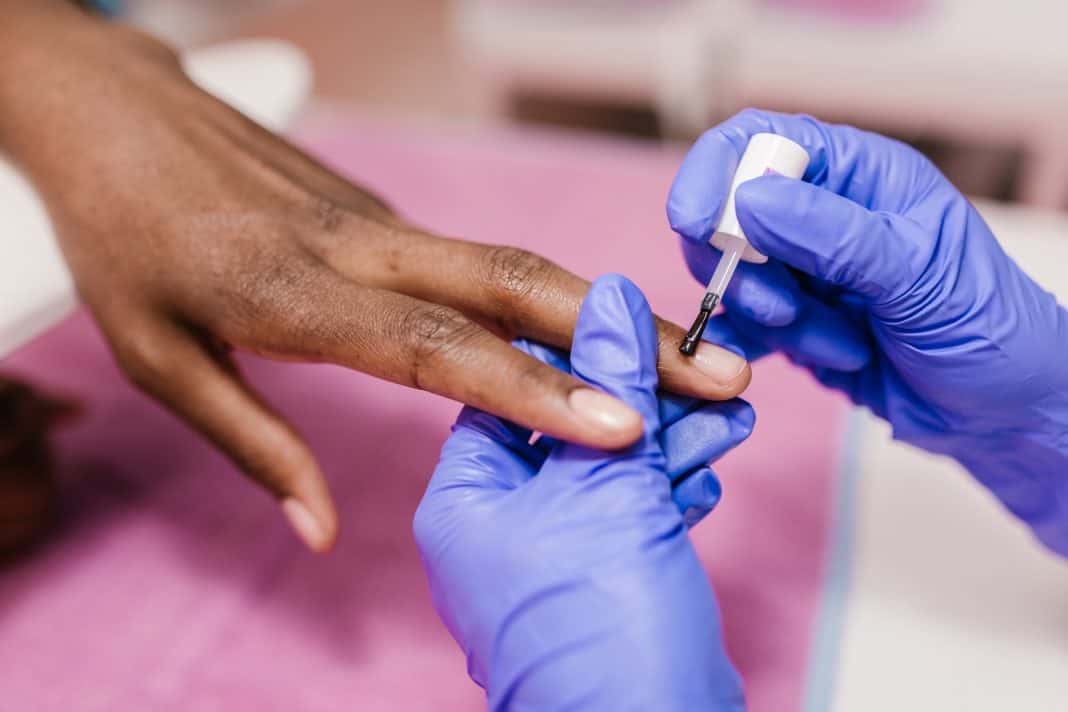As far as pleasures go, a quick pedicure is one that has always felt pretty guilt-free. It has always been one of my favorite ways to pamper myself at the end of a pregnancy or after a few difficult months of work or parenting. I love bringing a book along and just chilling for a few minutes before I get back to the day in, day out of being a working mom. But after developing an ingrown toenail after my last pamper session, I learned that my occasional pedicures weren’t as innocent as they seemed. In fact, there are all sorts of risks associated with getting pedicures, from irritation to infection and beyond.  Do yourself (and your nails) a favor by doing your diligence before revisiting your favorite salon. Below are seven ways to do just that.
Do yourself (and your nails) a favor by doing your diligence before revisiting your favorite salon. Below are seven ways to do just that.
When you walk in, give the place a once over.
I get it, the massage chairs, heated foot baths, and tropical tones are alluring, but if you want to be sure you’ve picked the right salon, you have to walk in with a critical eye. Don’t so much as put your name down for a pedicure unless you’ve had a good look at the salon. “It goes without saying that a salon should look clean—if it doesn’t, it probably isn’t, and you should go elsewhere,” says board certified dermatologist Robin Evans, MD. “Basins that your feet soak in should be cleaned in between clients. If you are not sure that this was done, ask the technician to clean it before you put your feet in.”  Don’t be afraid to turn around and walk out if you find yourself questioning the cleanliness of a salon. Ignoring your gut isn’t worth the risk.
Don’t be afraid to turn around and walk out if you find yourself questioning the cleanliness of a salon. Ignoring your gut isn’t worth the risk.
Understand cleaning and sanitation procedures.
There are many salons that are only going through the motions when it comes to keeping things clean, Evans says. She says that it’s common practice to place instruments in a container that appears to be a sanitation device, but it’s merely a storage container for the tools.  And according to Evans, a little soap and water isn’t good enough. “All metal tools that are used in a salon should … be cleaned in proper disinfectant solutions and then sterilized in an autoclave,” she says. “The type of autoclave really should be medical grade. For proper sterilization, the instruments should be placed in a clear packaged envelope that is sealed in the sterilization process.”
And according to Evans, a little soap and water isn’t good enough. “All metal tools that are used in a salon should … be cleaned in proper disinfectant solutions and then sterilized in an autoclave,” she says. “The type of autoclave really should be medical grade. For proper sterilization, the instruments should be placed in a clear packaged envelope that is sealed in the sterilization process.”  This type of care is warranted. It’s fairly common for the nail technician to cause microscopic nicks on a client during a pedicure, and without proper cleaning, this could become a vehicle for the transmission of bacteria, yeast, and even viruses. So, what are you looking for exactly? The Environmental Protection Agency has approved specific disinfectants, typically bright blue liquids stored in glass jars.
This type of care is warranted. It’s fairly common for the nail technician to cause microscopic nicks on a client during a pedicure, and without proper cleaning, this could become a vehicle for the transmission of bacteria, yeast, and even viruses. So, what are you looking for exactly? The Environmental Protection Agency has approved specific disinfectants, typically bright blue liquids stored in glass jars.  Worried you won’t be able to tell if an instrument has been properly cleaned? Take Evans’ advice and bring your own. Showing up with nail clippers, cuticle nippers, and cuticle pushers might get you a few strange looks, but it could also save you from being exposed to unwanted bacteria.
Worried you won’t be able to tell if an instrument has been properly cleaned? Take Evans’ advice and bring your own. Showing up with nail clippers, cuticle nippers, and cuticle pushers might get you a few strange looks, but it could also save you from being exposed to unwanted bacteria.
Know which tools are single-serve only.
If a salon is following proper sanitation practices, you should be okay using their metal tools. However, instruments like nail files and buffers can’t really be cleaned (in fact, anything non-metal should never be used on more than one client), and polish is used over and over again without any way to avoid sharing bacteria. “I personally saw a technician in a salon nick me [while cutting my cuticles] and then polish. They … touched my blood [with the brush] and then dipped directly in the nail polish bottle for the next customer’s use,” Evans shares.  The solution? Once again, Evans suggests bringing your own tools and polish. This is the surest way to be certain you won’t be sharing germs with another pedicure client. Ann Phillips, a licensed master aesthetician in Park City, Utah, and founder of Zerenity Spa, couldn’t agree more. In fact, she believes that making the investment in your own set of tools is not only the safest choice, but also the most economical, since high quality pedicures can be pricey.
The solution? Once again, Evans suggests bringing your own tools and polish. This is the surest way to be certain you won’t be sharing germs with another pedicure client. Ann Phillips, a licensed master aesthetician in Park City, Utah, and founder of Zerenity Spa, couldn’t agree more. In fact, she believes that making the investment in your own set of tools is not only the safest choice, but also the most economical, since high quality pedicures can be pricey.  “Sometimes, we all just need a quick, $10 manicure, but there are things you can do to ensure you are getting the best bang for even the cheapest buck,” she says. “A great way to get around spending a ton of money while making sure your skin won’t suffer later is to invest in your own set of tools. Bring them with you when you need a quick mani.”
“Sometimes, we all just need a quick, $10 manicure, but there are things you can do to ensure you are getting the best bang for even the cheapest buck,” she says. “A great way to get around spending a ton of money while making sure your skin won’t suffer later is to invest in your own set of tools. Bring them with you when you need a quick mani.”
Put these ingredients on your “never” list.
If you’re still set on getting a salon pedicure, you need to know what ingredients are in the products they will be using on your feet and nails. For starts, Evans says any polishes, topcoats, and base coats with ingredients like formaldehyde, toluene, and phthalates, should be avoided altogether. For instance, exposure to formaldehyde is associated with health risks such as skin irritation and reactions in the eyes, nose, and throat. Additionally, it is believed that high exposure to this toxic chemical is associated with an increased risk of cancer, according to the Environmental Protection Agency.  “These chemicals are toxic, potential allergens, and literature suggests possible carcinogenicity. Avoid them if at all possible,” Evans urges. So, what’s the solution? Thankfully, there are many salons that are starting to understand the risks associated with products containing these ingredients and are beginning to offer other options. Check out a salon’s website for information on what products they use. You should be able to review the ingredients in the salon.
“These chemicals are toxic, potential allergens, and literature suggests possible carcinogenicity. Avoid them if at all possible,” Evans urges. So, what’s the solution? Thankfully, there are many salons that are starting to understand the risks associated with products containing these ingredients and are beginning to offer other options. Check out a salon’s website for information on what products they use. You should be able to review the ingredients in the salon.  Additionally, Phillips advises against allowing nail technicians to use plain squirt bottles filled with product as it is basically impossible to know for sure what is in these containers. If you don’t have any luck there, look for providers of medical pedicures. These pedicures are held to a higher standard when it comes to sanitation procedures and product choices.
Additionally, Phillips advises against allowing nail technicians to use plain squirt bottles filled with product as it is basically impossible to know for sure what is in these containers. If you don’t have any luck there, look for providers of medical pedicures. These pedicures are held to a higher standard when it comes to sanitation procedures and product choices.
Do your skin a favor.
Making smart choices about your next pedicure isn’t just about avoiding bacteria and carcinogens: it’s about avoiding any products that could be hard on your skin. Do yourself a favor, and take Phillips’ advice on protecting your skin during a pedicure.  “Have you ever noticed that, about a week after you get a manicure or pedicure, [that] the skin around your nails and your cuticles is even worse than when you went in? It’s the reason so many people are willing to drop bigger bucks at fancier spas—and a lot of it has to do with one ingredient: alcohol,” she says. The key is to find a salon that picks products that don’t contain alcohol. You should be able to get a straight answer by simply asking before you make an appointment, according to Phillips, although she admits that the salons that avoid alcohol are probably going to have a higher price point.
“Have you ever noticed that, about a week after you get a manicure or pedicure, [that] the skin around your nails and your cuticles is even worse than when you went in? It’s the reason so many people are willing to drop bigger bucks at fancier spas—and a lot of it has to do with one ingredient: alcohol,” she says. The key is to find a salon that picks products that don’t contain alcohol. You should be able to get a straight answer by simply asking before you make an appointment, according to Phillips, although she admits that the salons that avoid alcohol are probably going to have a higher price point.  “Ask to take a peek at the ingredients, and ask your technician to avoid using anything with alcohol in it.”
“Ask to take a peek at the ingredients, and ask your technician to avoid using anything with alcohol in it.”
Think twice before getting a gel manicure.
Gel manicures are known for lasting for up to two weeks after the service, and they have become incredibly popular for this reason. However, there are safety issues you should take into consideration before jumping on the bandwagon.  Many salons use UV lamps to set the gel manicure. Although the exposure is fairly short, repeating this service time and time again can eventually cause damage to your skin, according to the American Academy of Dermatology. The good news is that there are precautions you can take. First of all, many salons are making the switch to LED lights, which are much gentler on the skin of your hands. If an LED light isn’t an option, make sure your hands are covered with fingerless gloves that have an ultravoilet protective factor.
Many salons use UV lamps to set the gel manicure. Although the exposure is fairly short, repeating this service time and time again can eventually cause damage to your skin, according to the American Academy of Dermatology. The good news is that there are precautions you can take. First of all, many salons are making the switch to LED lights, which are much gentler on the skin of your hands. If an LED light isn’t an option, make sure your hands are covered with fingerless gloves that have an ultravoilet protective factor.
Watch for signs of trouble after you leave.
As much as we all hope that following the guidelines listed above will keep you from facing infection or a reaction to a product, it is always a good idea to be on the lookout for the first signs of trouble after a mani or pedi.  “I have treated many patients for infections which they contracted from their local nail salons – the infections can be painful, usually require treatment with oral antibiotics, may require drainage procedures, and could result in scarring or permanent damage to or loss of nails,” shares Evans. Specifically, you want to watch for ingrown toenails, which will cause you pain and be swollen and tender to touch, according to Piedmont Healthcare. You should also keep an eye on your toenails, which will thicken and change color if you have a nail fungus. Infections can occur on your foot or legs and the first sign is redness and swelling. If any of these symptoms pop up, see your primary care physician right away.
“I have treated many patients for infections which they contracted from their local nail salons – the infections can be painful, usually require treatment with oral antibiotics, may require drainage procedures, and could result in scarring or permanent damage to or loss of nails,” shares Evans. Specifically, you want to watch for ingrown toenails, which will cause you pain and be swollen and tender to touch, according to Piedmont Healthcare. You should also keep an eye on your toenails, which will thicken and change color if you have a nail fungus. Infections can occur on your foot or legs and the first sign is redness and swelling. If any of these symptoms pop up, see your primary care physician right away.



